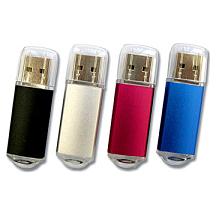 The USB, Universal Serial Bus, Flash Drive was introduced as an alternative to floppy disks with the advantage of being more reliable, more durable, much faster and with much larger storage capacity. Today the USB Flash Drives have completely replaced the aging floppy disks. Since they are mostly used to store and transfer digital files between computers the USB Flash Drives are seen as a complement to memory cards. Facts like size and lack of USB interface on small portable devices contribute also to the fact of not being a competitive storage format to memory cards.
The USB, Universal Serial Bus, Flash Drive was introduced as an alternative to floppy disks with the advantage of being more reliable, more durable, much faster and with much larger storage capacity. Today the USB Flash Drives have completely replaced the aging floppy disks. Since they are mostly used to store and transfer digital files between computers the USB Flash Drives are seen as a complement to memory cards. Facts like size and lack of USB interface on small portable devices contribute also to the fact of not being a competitive storage format to memory cards.Considering that every new desktop computer, laptop computer and printer has at least one USB interface the USB Flash Drive standard is the most compatible flash memory device for transferring digital files to and from a computer.
Since USB Flash Drives do not have a standardized form factor they can be found in many different sizes and designs, but in general they are no bigger than a lighter or a pack of gum. The same applies for the USB Flash Drive as a name, since it is not a standardized trademark it can be fund under many names. Such as Jump Drive, Pocket Drive and Pen Drive, still the USB Flash Drive name is the most common used when referring to USB based flash memory devices.
USB Flash Drives can be found with two different data transfer speeds. The USB 1.1 standard has a transfer speed of 1.5 MB/sec or 8 X and the USB 2.0 has a transfer speed of 60 MB/sec or 400 X. The speed of the USB 2.0 is the fastest in the memory card industry.
Life Cycle
The life cycle of a flash drive is a question which has been around for a long time. There are many factors which contribute to the longevity of a flash drive. Today, lets look at some.
I feel there are three main components which effect the life cycle of a USB flash drive.
* Memory type
* USB connection
* Chassis or case
Flash drives use two primary types of flash memory. There is SLC and MLC memory. SLC is Single Level Cell memory and MLC is Multi Level Cell memory. GetUSB.info did an in-depth write-up about SLC and MLC flash memory if you’re interested, but for this article we have:
* SLC memory is good for about 100,000 write cycles.
* MLC memory is good for about 10,000 write cycles.
Most UFDs use MLC memory because it’s cheaper to make and allows manufacturers to offer more storage in a smaller space. It’s difficult to figure out which type of memory a UFD has, but it doesn’t matter anyway - most flash drives are more limited by other factors.
Next, lets look at the limiting factor of the USB connector. This is the actual socket which connects the UFD to the host computer. Doing some research, most USB Type A socket manufacturers provide a specification called Mating Durability. The spec is around 1,500 connections. WOW, that sure limits the life cycle, but I doubt many would connect the UFD to a host over 1,500 times.
Last, the chassis or case help the USB life cycle. The chassis helps the UFD look cool, but also provides a small amount of protection against wear-n-tear. UFDs are exposed to all sorts of shock. Whether it be physical shock or electric shock, it’s important to treat your UFD with care. True, there are some indestructible flash drives out there, but the point here is try not to let external factors instantly destroy your drive. The best method for shock protection is A) don’t drop, slam or smash your UFD and B) keep the cap on so the connectors don’t rub or touch another object which could create electric shock.
So, to sum everything up: Given you don’t physically ruin your drive, you have about 1,500 connections and about 10,000 write cycles before you can expect the USB life cycle to become questionable.
Source :
- USB Flash Drive
- What is the Life Cycle of a USB Flash Drive?
4 comments:
nice
i like the design
i like the design
Totally helped with my storage devices project
Post a Comment